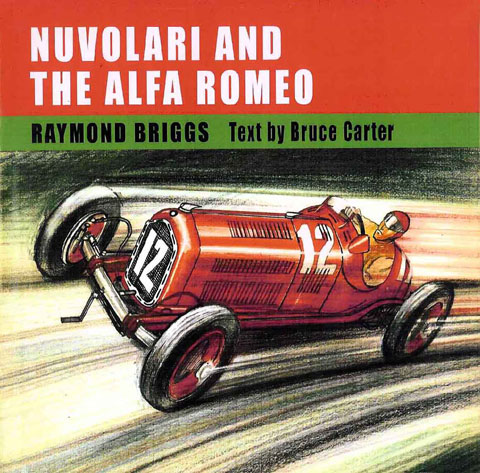
Text by Bruce Carter, Illustrations by Raymond Briggs (copyright 1968, 2006)
New Edition by Racemaker Press, LCC (2006)
ISBN 0-9766683-1-9
For ages 8 and up
37 pp (no pagination)
$20 + S/H
$40 + S/H for boxed set of Nuvolari and the Alfa Romeo and Jimmy Murphy and the White Duesenberg
ORDER FROM www.racemaker.com
By Patricia Lee Yongue
Mantua, Italy’s motorsports “Maestro,” Tazio Nuvolari (1892-1953), engineered one of Carter’s and Briggs’s two historic moments in racing history at the 1935 German Grand Prix, held one rainy July day on the famed Nurburgring. Indeed, racing for a spectacular win for Italy against Hitler’s prized silver Auto Union and Mercedes-Benz teams was Nuvolari’s mission. But as Carter emphasizes to young readers, both Nuvolari, at 43, and his car, a red Scuderia Ferrari Alfa Romeo P3 (Tipo B Monoposto) were “old” compared to the much favored German mechanical and human speedsters–especially the “thoughtful” champion Rudolf Caracciola (Mercedes-Benz); “the idol of the young,” handsome Bernd Rosemeyer (Auto Union); and the “wild” aristocrat, Manfred von Brauchitsch (Mercedes-Benz). Age, however, seemed no obstacle for Nuvolari, “as daring and as clever as when he was a young man racing motorcyles.”
The issue would be the aged #12 Alfa.
But pre-teens, awkward and uncertain, like an “Underdog” story as much as they like Superhero adventures. (So do adults!) Carter’s challenge would be convincing youngsters that aging constitutes underdogging.
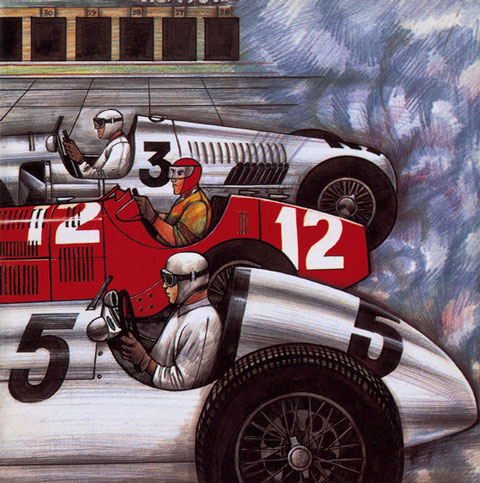
From the book; illustration by Raymond Briggs.
Nuvolari’s Alfa P3 had experience in car years equal to its driver’s, but at first that attribute seemed a liability. Despite its Dubonnet independent front suspension and an increase in volume from the original 2.6 to 3.8, it was still hopelessly underpowered, and its old-fashioned body drew laughter from those without a worry about the streamlined German cars’ imminent victory. To everyone but Nuvolari’s and his crew’s surprise, however, the P3’s construction would enable its road holding and cornering facility in the wet, slick conditions. A less experienced driver might have had trouble managing the car, certainly, but Nuvolari knew the P3’s personality as well as he knew the Nürburgring’s. He “knew every inch of the slippery concrete, every corner and every gradient. He knew all the dangers. . ..”
And so Tazio Nuvolari qualified as Carter’s kind of hero—passionate, patriotic, skilled, brave, knowledgeable, smart. All “the skill and experience” man and machine possessed, as well as a competitor’s natural daring and his knowledge of every detail and quirk of the circuit, would deflate the German ambition and would caution Carter’s young readers not to discount the power of maturity. Driving flat out had its advantages, but on as slippery and dangerous a road course as the Nürburgring proved to be the day of the German GP, acquired smarts was a greater advantage. Even von Brauchitsch, known for his early wild driving, had discovered through experience the necessity of strategy and finesse.
In racing, though, luck always matters, and Carter does not downplay its agency. Von Brauchitsch, for example, had more than his share of bad luck that translated directly into Nuvolari’s good luck. For the benefit of his young audience, however, Carter continues to emphasize qualities that require experience and maturity to flourish, including the sharing of spirit with the car. In the heat of the drive to attain first, Nuvolari “appeal[ed] to his beloved old Alfa Romeo, and beating the side panel of his car as if he were a jockey urging on his horse. Corri! Corri! Corri!”
Carter clearly intends to provide lessons and inspiration for his young readers. He also provides adventure. Obviously, to do so, he and Briggs trim down the field of competition to Nuvolari and the three Germans. But in many ways that view of the contest was precisely the way Nuvolari and motorsports writers saw it. The Mantuan wanted to win in any event, yet he especially wanted to win against the designated pride of the Third Reich. And a dramatic win it was.
Almost from the get-go, the #12 Alfa lay center to the two German cars. “Caracciola in his Mercedes shot away from the front row like a bullet, leaving a cloud of spray behind him. Nuvolari made a perfect get-away, too, judging the speed of his engine so that there was little wheelspin on the wet road. The Auto-Union was skating about dangerously. These German cars had 400 horsepower engines and they had to be tamed carefully.”
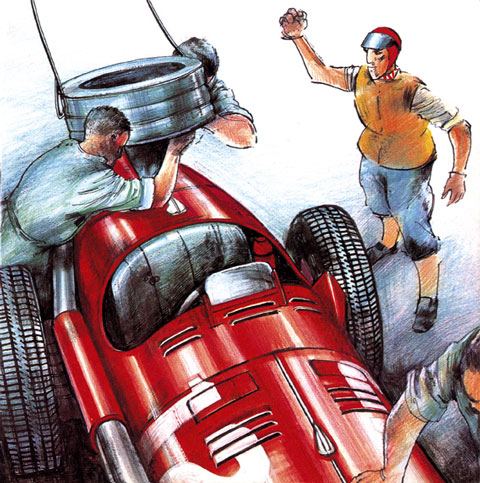
From the book; illustration by Raymond Briggs.
The riproaring pace for the Alfa diminished, however, as Nuvolari gradually fell to sixth place. But then he retook the lead, only to lose it for a pit stop and a bad refueling job (a fuel pump handle broke).
That stall occurred midway through the race. And as Nuvolari “raced past the Mercedes pits” on his way back to fourth place on the circuit, more than a minute behind the leader von Brauchitsch, “the German mechanics waved and laughed good-humoredly. ‘He’ll never catch up now,’ they were saying to one another.”
Now, however, “the Flying Mantuan” had to muster up his determination for the final skirmish. So did the Alfa.
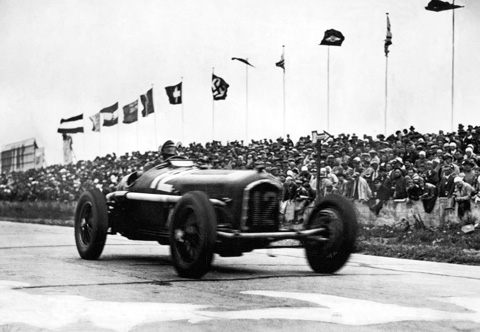
Real life photo, real life hero. Nuvolari takes the checkered flag after defeating both the Auto Union and Mercedes Benz teams on their home Grand Prix. Courtesy Jon Shirley collection.
With luck going his way and three laps to the finish, Nuvolari “found the spirit and courage he needed at this critical moment.” He drove “like a demon.” For its part, the speedy “old Alfa Romeo was running perfectly, giving out all its power as if determined that its driver would do the impossible.” Driver and car sped past Caracciola. Then, when von Brauchitsch’s Mercedes, the “silver shape” Nuvolari could just make out within “a cloud of spray,” burst a left rear tire but a few miles from the finish line, Italian man and car headed for victory.
“Alone on the wide, rain-soaked track appeared a small red dot. It grew into the upright shape of an old Alfa Romeo, thundering along at top speed, winning the German Grand Prix.”
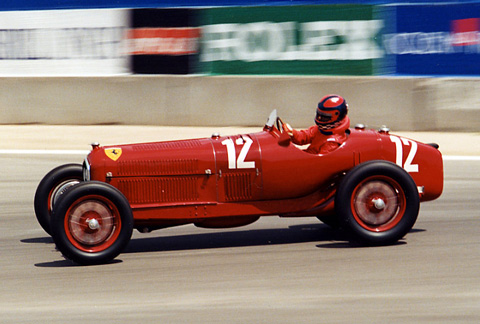
Jon Shirley is the current custodian of the Nuvolari P3. Read interview with Shirley. Photo courtesy Jon Shirley.
What might confuse young readers is that man introduced as the “patriotic Italian” who “loved Italian cars” subsequently realized the Alfa’s inevitable deficiencies and eventually “joined the German Auto-Union team and won many races for them,” information Carter records non-judgmentally in the appendix to the narrative. Carter never mentions Auto Union’s origins and the connection with Hitler.
The second volume, “Jimmy Murphy and the White Duesenberg” will be reviewed next week.
Ah! My favorite kind of story — the underdog Alfa paired with the magical driver. Lucky Jon Shirley to now be the custodian of this piece of automotive history.
I wish I had known about this book when my son was growing up. Thanks again Pat for another great article!
Thanks for this article, I remember reading this book as a child (I’m 46 now) seeing those pictures from that book again really takes me back.The P3 is still one of my favorite cars. I have been looking on ebay for revivals 1/20 scale of it, it even looks beautiful in model form and revival really did a great job of it, heck I should know, I have been a professional model maker. I rember reading the the snippit in the back of the book about the car and then about Tavio and how he “quietly died in his sleep” at a ripe old age…I broke down sobbing and telling my Dad, He had a little difficulty getting me to bed that night. Thanks again, also I wanted to know if any of thoughs wonderful drawings are availible in prints ???? thanks again
Damian J Evans